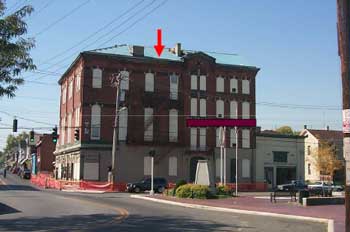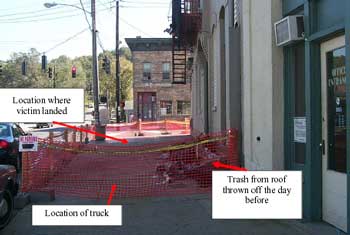Roofing Laborer Dies After 60-Foot Fall
KY FACE #03KY097
Date of Incident: October 7, 2003
Report Release Date: May 27, 2004
Summary
At 8:00 AM on the morning of October 7, 2003, a 33-year-old laborer, working for a roofing contractor, was removing debris from a commercial building roof when he slipped and fell 60 feet to the sidewalk below. There were 2 other laborers and the contractor at the work site that morning. It was the second work day at this particular job site and the three workers were to finish discarding bags of debris from the roof. The decedent and one of the laborers accessed the roof through the building interior, up a flight of stairs to a five-step ladder which led to the roof opening. Two personal fall arrest systems were available for the laborers to wear before they accessed the roof area. The personal fall arrest systems were secured to roof anchors by 25 foot lanyards so that when the laborers entered the roof area, they were wearing a personal fall arrest system and already tied off. The third laborer was in a pick-up truck parked next the building and the contractor was standing by the truck to load the bags of debris dropped off the roof by the two laborers.
When the laborers approached the roof access, Laborer No. 1 used the personal fall arrest system and accessed the roof first. Laborer No. 2, the decedent, accessed the roof without using the personal fall arrest system. He grabbed a bag of trash and began walking toward the edge of the roof when he slipped and fell 60 feet to the sidewalk below. He died due to multiple blunt force injuries.
To prevent future occurrences of similar incidents, the following recommendations have been made:
- Employers should have a written safety policy outlining safety practices, procedures and which state the consequences of not following the company policies.
- Employers should provide appropriate personal safety equipment and training on the proper use of that equipment.
- A competent person should conduct a hazard assessment of the job site prior to commencement of work. Control of the identified hazards and safe work procedures should be discussed.
- Employers should have a site specific fall protection plan written by a qualified person.
Background
A roofing company in business for approximately one year was contracted to replace a roof on a commercial building. The owner of the company had 15 years of roofing experience working for other contractors. During the last five years as an employee for other contractors, the employer had started a part-time roofing and siding business of his own. Laborers were employed on an as-needed basis.
All personal fall arrest equipment needed for each job was provided to each employee by the employer. Company safety procedures required each employee to wear and use necessary safety equipment and personal protective equipment. Failure to comply with company safety rules resulted in the termination of employees. Safety procedures were discussed, but the company did not have a written safety manual.
Several months before the incident, the decedent had worked as a temporary employee for the company for one day. The decedent had been re-hired by the company the day before the incident.
Investigation
At 8:00 AM on the morning of October 7, 2003, a 33-year-old roofing laborer, was discarding his first bag of debris off a commercial building’s roof when he slipped and fell 60 feet to the sidewalk below. There were 2 other laborers and the contractor at the work site that morning. It was the second work day at this particular job site and the three were to finish removing bags of debris from the roof as they had done the day before. The decedent and one of the laborers accessed the roof through the building, up stairs and various ladders to a five-step step-ladder which led to the roof opening. A safety harness and a safety belt, each with attached lanyards clipped to roof anchors, were located inside the roof access. Before entering the roof area, each laborer was to wear a personal fall protection system. After putting on the safety equipment, the laborers could then access the roof safely. It was suspected that there was dew on the roof. It is unknown and if either man was wearing anti-skid shoes or gloves. A third laborer was sitting in the cab of the pick-up truck parked on the sidewalk parallel to the building. The contractor was standing on the sidewalk by the truck waiting for the two laborers on the roof to throw down bags of debris into the bed of the pick-up truck.
As the laborers approached the roof access, Laborer No. 1 dressed in the safety harness and accessed the roof. Laborer No. 2, the decedent, accessed the roof without dressing in the safety belt. Laborer No. 1 did not see Laborer No. 2 climb past the safety belt without putting it on and access the roof. Without it, Laborer No. 2 grabbed a bag of trash and began walking toward the edge of the roof when he slipped and fell 60 feet to the sidewalk below. Laborer No. 1 did not see Laborer No. 2 fall, but heard him falling off the roof. After the laborer fell, the owner and other laborer on the ground went to him, assessed the situation and called emergency services who arrived on the scene within minutes. Several people observed the laborer fall from the roof. One witness also called emergency services. Emergency personnel arrived and contacted the coroner who declared the victim dead at the scene.
Cause of Death
According to the autopsy report, death was due to multiple blunt force trauma caused by a fall from a great height.
Recommendations/Discussion
Recommendation No. 1: Employers should have a written safety policy outlining safety practices, procedures and which state the consequences of not following the company policies.
Discussion: The company involved in this fatality did not have written safety procedures. Employees were verbally instructed to wear personal fall arrest equipment and shown how to use it. One employee interviewed stated that if safety equipment was not worn, they were not allowed to work. Occupational Safety Health Standard CFR 1926.503(a)(1) states that the employer is responsible for providing a training program for each employee that might be exposed to fall hazards. This training should be in writing with explanations of consequences if the program is not followed. All training should be documented. Employees should be required to sign that they understand the safety and training program, the enforcement and consequences for failure to follow safety instructions.
Recommendation No. 2: Employers should provide appropriate personal safety equipment and training on the proper use of that equipment.
Discussion: A body belt and a harness were the personal fall arrest equipment provided by the company for the victim and the survivor to wear as fall arrest systems. The Occupational Safety and Health Standard CFR 1926.502(d) states that body belts can be used as positioning devices but they are unacceptable for use as a fall protection system. A full body harness should have been provided for mandatory use by all employees and all employees should be trained in the proper use of this equipment.
Recommendation No. 3: A competent person should conduct a hazard assessment of the job site prior to commencement of work. Control of the identified hazards and safe work procedures should be discussed.
Discussion: A hazard assessment of each job site should be performed each day before work commences. The identified hazards and safe work practices should be examined and discussed with all affected employees. It is thought that there may have been dew on the roof and appropriate precautions should have been taken (i.e.: anti-skid shoes in addition to the appropriate personal fall arrest system).
Recommendation No. 4: Employers should have a site specific fall protection plan written by a qualified person.
Discussion: Occupational Safety and Health Standard CFR 1926(503)(k)(1) states that a fall protection plan shall be prepared by a qualified person and developed specifically for the site where the work is being performed. Employees should be reminded every work day of the hazards identified for the work place and to wear the personal protective equipment to prevent injury while working.
References
- Occupational Safety and Health Standard CFR 1926.503(a)(1)
- Occupational Safety and Health Standard CFR 1926.502(d)(8)
- Occupational Safety and Health Standard CFR 1926(503)(k)(1)
Acknowledgements
Company owner
Coroner
Kentucky Occupational Safety & Health Officer
Local police department
Illustrations

|
|
Building from which laborer fell. Red arrow indicates location of fall.
|

|
|
Location where victim landed.
|
The Kentucky Fatality Assessment & Control Evaluation Program (FACE) is funded by a grant from the Centers for Disease Control and the National Institute of Safety and Health. FACE’s purpose is to aid in the research and prevention of occupational fatalities by evaluating events leading to, during, and after a work related fatality. Recommendations are made to aid employers and employees to have a safer work environment. The current foci of the program are occupational fatalities involving: construction, machinery, immigrant workers (particularly Hispanics) or youths.
To contact Kentucky State FACE program personnel regarding State-based FACE reports, please use information listed on the Contact Sheet on the NIOSH FACE web site Please contact In-house FACE program personnel regarding In-house FACE reports and to gain assistance when State-FACE program personnel cannot be reached.
|
|
Back to NIOSH FACE Web
